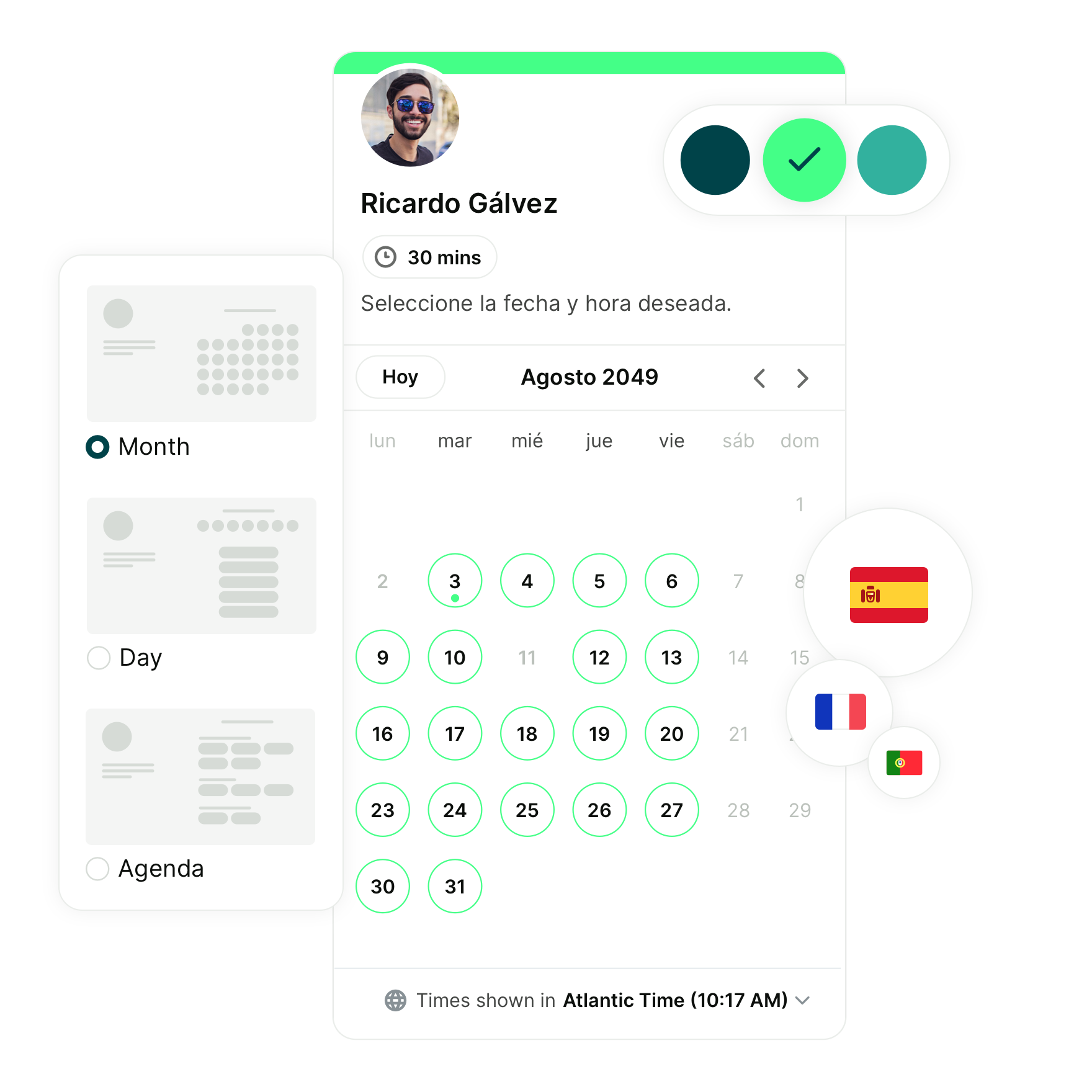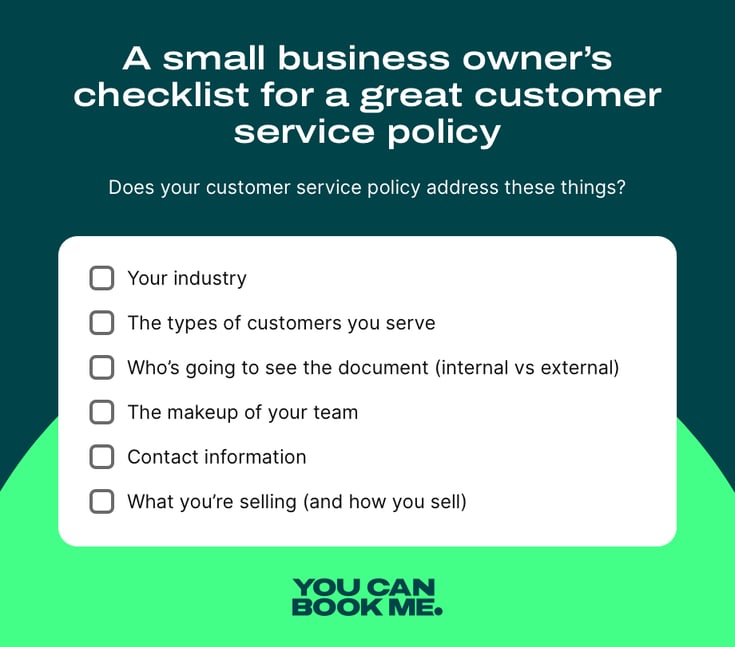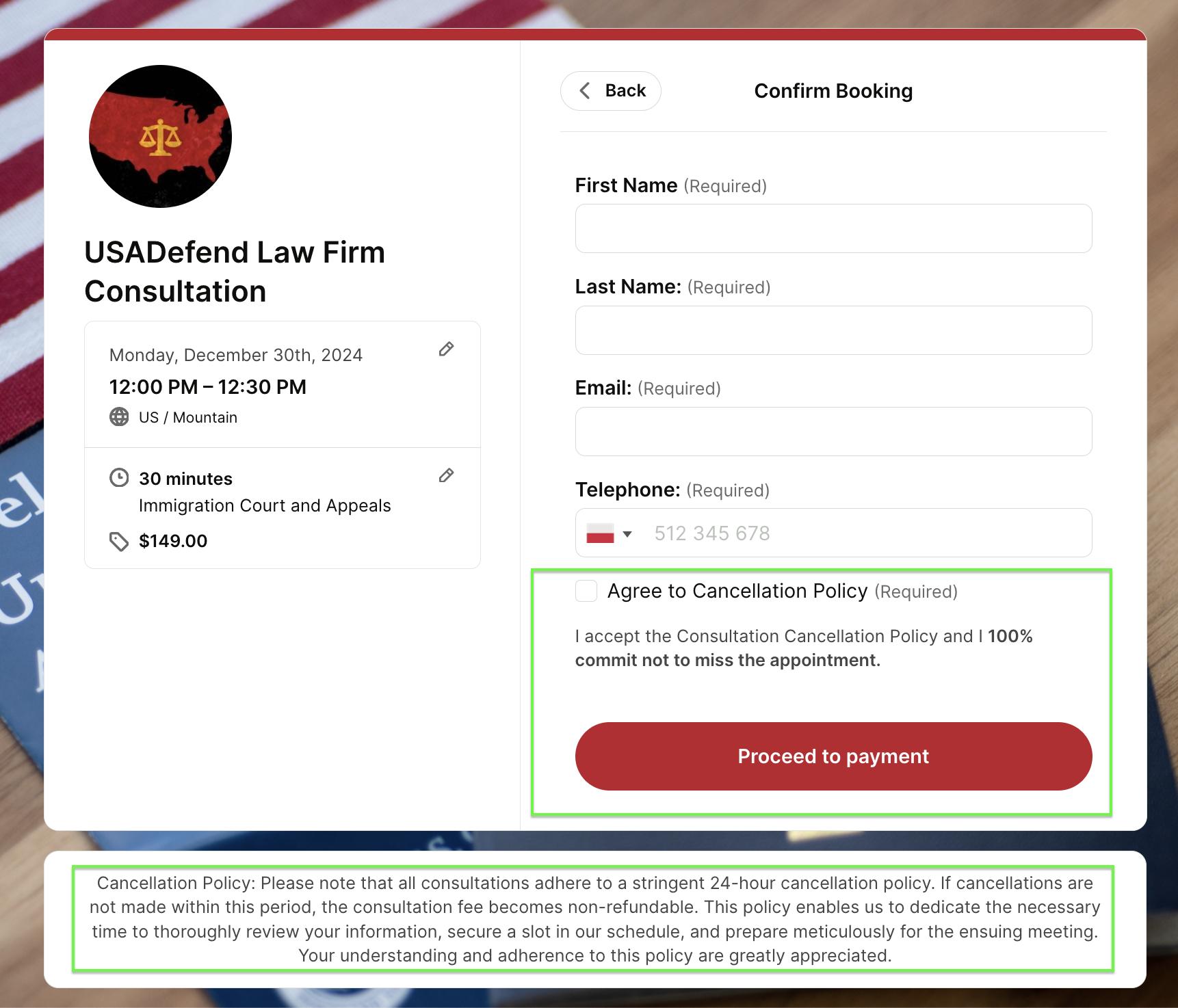9 Customer Service Policy Templates for Small Businesses
Actions speak louder than words—but words are important, too. Follow these customer service policy templates to accurately set expectations with customers and employees.

Hailey Hudson

Ready to book more meetings?

Contents
- What is a customer service policy?
- Does your business need a customer service policy?
- What does a successful customer service policy include?
- Developing effective customer service procedures
- Why you shouldeview customer feedback to keep your service policy up-to-date
- Real-world examples of customer service policies
Delivering exceptional experiences is a priority for customers. And your job is to empower your employees to consistently deliver high-quality customer service for them. The best way to achieve this goal is through a customer service policy.
By writing and sharing a strong customer service policy, you’ll communicate your values to employees and customers alike, smoothing out interactions by providing a set of guidelines to follow.
But, to achieve this, it's essential that your customer service policies are easily accessible and align with your company's culture and values.
That's why we’re breaking down what goes into a customer service policy to help you create one for your own business. You’ll also find real-world examples to get inspired by.
What is a customer service policy?
A customer service policy is a statement that explains how your business interacts with customers and what your employees should do in case of a problem.
It provides standard operating procedures (SOP) for all employees to follow, ensuring that each and every customer gets the same quality service.
This policy is beneficial because it gives your customer service team clear expectations, resulting in better customer outcomes. It’s similar to a privacy policy, but focuses on behavior rather than data.
💡 Pro tip: If you're going through the motions of documenting all of the necessary policies for your business, check out this comprehensive list of small business policies you should consider.
Your service policy also explains your approach to customer service to your clients. Whether it's around refund policies, service commitments, response times, or quality guarantees, it's a great tool for setting customer expectations from day one.
Does your business need a customer service policy?
Yes! Your business needs a customer service policy that states how you interact with consumers and promises a good experience.
Customer expectations are reaching an increasingly higher standard. In one report, a whopping 96% of surveyed customers said subpar customer service affected their loyalty to a brand. But if a business solves customer problems quickly, said another survey, customers are 2.4x more likely to stay.

Particularly since the pandemic, corporate empathy and responsiveness are key—and a strong customer service policy is a great way to reassure customers exactly what you’ll provide.
Benefits of a customer service policy
An effective customer service policy is beneficial because it:
- Communicates business values to customers and employees. Determine what you stand for and then shout it loud and proud—holding yourself accountable to meet those values and standards with every interaction.
- Empowers employees to be autonomous. Team members have the confidence and freedom to make decisions when necessary, without senior leadership being a blocker.
- Serves as a documented SOP. A customer service policy provides standard operating procedures for everyone to follow, increasing productivity and efficiency without compromising quality.
|
Pro tip 💡 Tools like Flipsnack, which enable teams to create and distribute branded materials with ease, can support these policies by ensuring consistent communication and presentation across all customer touchpoints. |
- Improves customer retention. Just 20% of consumers say they’d come back to a brand that had a poor customer experience. Conversely, when you provide better support, customers are more likely to stay.
- Sets clear expectations. Finally, a customer service policy clearly outlines expectations for both your customers and your customer service team.
What a successful customer service policy includes
The exact content of your policy will vary depending on a few factors. For instance, you’ll want to consider:
- The industry you’re in. A barber shop will have a different policy than a lawyer’s office.
- The types of customers you serve. B2C customers and B2B buyers, for example, can have different expectations or a different tone of voice.
- What you’re selling. Interactions with customers will likely differ based on whether you’re selling products or services. Make sure your policy reflects these nuances.
- Customer service mission statement. This is a foundational element that guides how your customer service practices and ensures alignment with your company's overall vision and values.
- The makeup of your customer service team. Think about setting realistic expectations. For example, if you have only a single support person, 24-hour service won’t be realistic—so consider implementing omnichannel customer support to manage inquiries more efficiently within available hours.
- An internal vs. external doc. Think about whether you’re writing your policy for an audience of employees or customers. An internal policy will likely cover internal tools and talk about specific roles and responsibilities (some of these things can be combined with your employee policy). An external policy focuses on what your customers can expect when doing business with you.

While these are some of the factors that will alter what to include in your policy, there are also a few foundational elements that hold steady, regardless of your business type. Let’s walk through a few of them:
A deep understanding of customer needs and expectations
The first step to any good customer service policy: An in-depth, comprehensive understanding of what your customers need, what they expect, and how to exceed customers' expectations.
For example, some industries don’t need immediate responses. Others, such as retail businesses, do. And as for SaaS companies, having thorough software documentation can ensure that your service team is well-equipped to handle customer inquiries efficiently. Your policy needs to be tailored to reflect what your target audience expects.
Unsure what your specific customer base is looking for? Learn about their expectations by running focus groups; scheduling 1:1 customer interviews; or conducting social listening with a platform like SparkToro.
Objectives or commitments
A customer service policy should focus on internal objectives and how they translate to external commitments. Maybe integrity is one of your company’s core values. If so, your customer service policy could state that consumers can expect nothing but 100% honesty in every employee interaction.
So, what commitments are you making to customers? Some examples could be:
- 99% uptime of your product
- Response within 24 hours
- Free returns
Think about the commitments you want to make to customers. But, make sure they're commitments that you can make as well.
A clear understanding of your policies
As part of your own customer service policy, clearly state your refund policy for customers to see. A refund policy simply explains whether you give full monetary refunds on returns. Be clear about your process for returns and whether customers should expect to get their money back.
If relevant, your cancellation policy should make an appearance, too. This policy protects you from losing revenue when customers cancel their service or appointment last-minute. Explain whether customers can cancel without being charged a fee.
|
💡 Your customer service policy is just one type of policy your business needs. Explore some other common and important policies to consider for your small business: |
Developing effective customer service procedures
It's important that as you write your customer service policy, it's easy for your customer service team to understand and implement it. After all, they're the ones who are responsible for managing customer inquiries.
Well-defined customer service procedures help to standardize responses and actions, ensuring consistency across all customer interactions. This consistency is key to building trust and reliability with your customers, as they know what to expect every time they engage with your business.
Outlining your procedures and protocols
As part of your internal customer service policy, your procedures, protocols, and workflows should be well-defined and documented to maximize customer satisfaction.
They should outline the steps to be taken in different scenarios, such as handling customer complaints or resolving conflicts. These procedures should be communicated to all employees and be easily accessible, ensuring that everyone is empowered to deliver high-quality customer service.
Some scenarios that you can document instructions for include:
- How to greet customers
- How to tackle problems or angry customers
- When to escalate
- Ways to turn an angry customer into a happy one
You can also set time-to-response expectations (for example, within 24 hours).
Review customer feedback to keep your service policy up-to-date
Before we get to the customer service policy examples, we need to talk about the importance of incorporating customer feedback into your service policy.
A great customer service policy isn’t just a one-time document—it should evolve with your customers' needs. Regularly reviewing customer feedback will help your business:
- Identify customer pain points
- Refine and update existing policies
- Improve overall service quality
- Are customers frequently frustrated with response times?
- Do they have recurring issues with returns or refunds?
- Are customers frequently complaining about product quality?
Monitoring these insights on a regular cadence allows you to revise your customer service policy to address common concerns and enhance the customer experience.
Highlight your customer service wins
Reviewing customer feedback doesn't just have to be about the negative. Beyond solving problems, feedback also highlights what’s working well. If customers consistently praise a particular aspect of your service, you can reinforce those practices across your team.
To stay ahead, make feedback analysis an ongoing process. Schedule periodic policy reviews, involve your customer service team in discussions, and ensure those updates align with your company’s values and goals. A business that listens, adapts, and improves is one that earns long-term customer loyalty.
9 Real-world customer service policy examples
A customer service policy is primarily an internal document. It’s there for your employees to reference when needed. But you can also share your policy publicly to help set customer expectations. Take a look at these great customer service policy examples to get ideas for your own:
1. USADefend: Notification methods
Lucky for the USADefend team, they're already lawyers! So, they've got the in-house knowledge to best put together a great customer service policy on their website. Part of this includes letting existing and prospective customers their terms when it comes to sending out communications.
 This also means that, when clients book directly via their booking page, they've got their bases covered when it comes to sending out SMS notifications for upcoming appointments.
This also means that, when clients book directly via their booking page, they've got their bases covered when it comes to sending out SMS notifications for upcoming appointments.
Explore how to customize your booking page to better incorporate your customer service policy from other small business owners like Christian M. Frank-Fas, Esq.

2. Abel Womack: Code of conduct
Your customer service policy is a great place to consider including a code of conduct—guidelines that offer a blueprint for customer interactions. Abel Womack, a material handling solution company, used its customer service policy to outline a code of conduct explaining what customers can expect from the business.

3. Indeed: Organized and comprehensive
This customer service policy from Indeed covers a lot of information. But it’s easy to navigate thanks to a clickable navigation menu structured into neat bullets. And we completely agree with the statement Indeed makes at the top of the page: Customers shouldn’t have to wonder or guess about your processes or procedures. They’re entitled to as much knowledge as possible.

4. Good Business Charter: Company values
In Good Business Charter’s customer service policy, they do an excellent job of drawing on their company values and explaining how each one translates to good service. All companies that are accredited by the GBC, the policy states, must follow responsible pricing standards.

5. VEVOR: Return policy
Looking for an example return policy? VEVOR, a tool company, clearly states its process for returns and replacements—including tables listing reasons why you might or might not get a free return.

6. Princess Polly: Make it interactive
Popular online clothing boutique Princess Polly structured its customer service policy as a collection of frequently asked questions. For website visitors, this is easier to navigate than a large wall of text.

7. Wavestone: Getting specific
Wavestone has a well-thought-out customer satisfaction policy that’s clearly described on its website. The company explains the main elements that go into this policy, and gets specific about how these values affect customer interactions.

8. YouCanBookMe: Product uptime service policy
As a SaaS product, YouCanBookMe offers us another great example of an element to include in your customer service policy. In their terms of customer service, they outline their commitments to product uptime. They also provide an option for customers to reach out to their customer service team should they run into problems.
This is done with the statement:
"Although we aim to offer you the best service possible, we make no promise that our Service will meet your requirements. We cannot guarantee that the Service will be fault-free. If a fault occurs with the Site or the Service you should report it to team@youcanbook.me and we will attempt to correct the fault as soon as we reasonably can."  And to wrap it all in a nice bow, YCBM's service policy also reiterates their commitment to delivering top notch customer service to users.
And to wrap it all in a nice bow, YCBM's service policy also reiterates their commitment to delivering top notch customer service to users.
9. Mack Weldon: Customer satisfaction guarantee
If you're in the business of selling physical products, you may follow Mack Weldon's lead with their "try on guarantee". Their service policy promises that if a customer doesn't love the first pair of underwear they purchase, they'll make it right by:
- Sending a different size or style
- Issue a refund
- Let the customer keep their pair of underwear

Wrapping up
Running a small business isn’t easy, but you’ve got this. Your customers deserve a smooth experience every time, and a solid customer service policy makes that happen—if you stick to it!
Grab our templates to build your own policy, but don’t stop there. With YouCanBookMe, you can set up a booking page that covers everything—policies, cancellations, and more. It’s quick, simple, and makes a big difference for your customers. Try it for free—you’ll wonder why you didn’t start sooner!
FAQ about customer service policy templates
What are customer service policies?
A customer service policy is a statement that explains how your business interacts with customers. Think of your policy as a set of guidelines, promising a good customer experience and instructing employees on how to make it happen.
How do you write a customer care policy?
Start by making sure you understand the needs, wants, and expectations of your customers. Next, consider your core company values and how those translate into service interactions. Finally, outline your promise to your customers by stating the guidelines employees should follow, with a focus on providing excellent customer service of course.
What is a customer complaint policy?
A customer complaint policy provides a set of guidelines to follow when you receive a customer complaint. For example, you might follow a procedure that involves listening to the customer, investigating the issue, and then making it right.
How do I create a customer service policy?
Here's a quick overview of the steps you need to take to create your first customer service policy:
- Define your values – Focus on responsiveness, empathy, and problem-solving.
- Set expectations – Outline response times and support channels.
- Standardize processes – Create guidelines for handling inquiries and complaints.
- Empower your team – Allow flexibility within clear resolution policies.
- Train & improve – Regularly update based on feedback and best practices.
What are the 5 R's of customer service?
The 5 R’s of customer service help build strong customer relationships. Here’s what they mean:
- Reliability – Deliver consistent and dependable service.
- Responsiveness – Address customer needs quickly and efficiently.
- Respect – Treat every customer with kindness and professionalism.
- Resolution – Focus on solving problems effectively.
- Reputation – Maintain a positive brand image through excellent service. Ultimately, care more about what your customers say about you (than what you think of your business).
Mastering these principles leads to loyal customers and long-term success!
Subscribe to our newsletter
Get productivity tips, news, articles and resources.
Written by
Hailey Hudson
Hailey is an Atlanta-based, full-time freelance writer who works with clients in the healthcare, marketing, and tech industries. When she's not writing, she's probably belting musical theatre songs or snuggling with her feline WFH supervisor, Windy.



